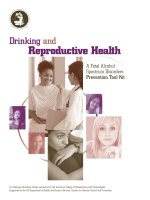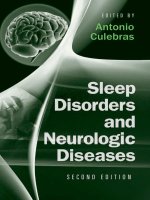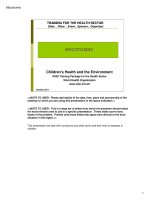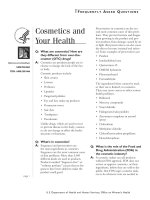Vitamins and Minerals Demystified potx
Bạn đang xem bản rút gọn của tài liệu. Xem và tải ngay bản đầy đủ của tài liệu tại đây (8.45 MB, 361 trang )
Vitamins and Minerals
Demystified
Demystified Series
Accounting Demystified
Advanced Calculus Demystified
Advanced Physics Demystified
Advanced Statistics Demystified
Algebra Demystified
Alternative Energy Demystified
Anatomy Demystified
asp.net 2.0 Demystified
Astronomy Demystified
Audio Demystified
Biology Demystified
Biotechnology Demystified
Business Calculus Demystified
Business Math Demystified
Business Statistics Demystified
C++ Demystified
Calculus Demystified
Chemistry Demystified
Circuit Analysis Demystified
College Algebra Demystified
Corporate Finance Demystified
Data Structures Demystified
Databases Demystified
Differential Equations Demystified
Digital Electronics Demystified
Earth Science Demystified
Electricity Demystified
Electronics Demystified
Engineering Statistics Demystified
Environmental Science Demystified
Everyday Math Demystified
Fertility Demystified
Financial Planning Demystified
Forensics Demystified
French Demystified
Genetics Demystified
Geometry Demystified
German Demystified
Home Networking Demystified
Investing Demystified
Italian Demystified
Java Demystified
JavaScript Demystified
Lean Six Sigma Demystified
Linear Algebra Demystified
Macroeconomics Demystified
Management Accounting Demystified
Math Proofs Demystified
Math Word Problems Demystified
MATLAB
®
Demystified
Medical Billing and Coding Demystified
Medical Terminology Demystified
Meteorology Demystified
Microbiology Demystified
Microeconomics Demystified
Nanotechnology Demystified
Nurse Management Demystified
OOP Demystified
Options Demystified
Organic Chemistry Demystified
Personal Computing Demystified
Pharmacology Demystified
Physics Demystified
Physiology Demystified
Pre-Algebra Demystified
Precalculus Demystified
Probability Demystified
Project Management Demystified
Psychology Demystified
Quality Management Demystified
Quantum Mechanics Demystified
Real Estate Math Demystified
Relativity Demystified
Robotics Demystified
Sales Management Demystified
Signals and Systems Demystified
Six Sigma Demystified
Spanish Demystified
SQL Demystified
Statics and Dynamics Demystified
Statistics Demystified
Technical Analysis Demystified
Technical Math Demystified
Trigonometry Demystified
UML Demystified
Visual Basic 2005 Demystified
Visual C# 2005 Demystified
Vitamins and Minerals Demystified
XML Demystified
Vitamins and Minerals
Demystified
Dr. Steve Blake
New York Chicago San Francisco Lisbon London
Madrid Mexico City Milan New Delhi San Juan
Seoul Singapore Sydney Toronto
Copyright © 2008 by The McGraw-Hill Companies, Inc. All rights reserved. Manufactured in the United States of America. Except
as permitted under the United States Copyright Act of 1976, no part of this publication may be reproduced or distributed in any form
or by any means, or stored in a database or retrieval system, without the prior written permission of the publisher.
0-07-159471-X
The material in this eBook also appears in the print version of this title: 0-07-148901-0.
All trademarks are trademarks of their respective owners. Rather than put a trademark symbol after every occurrence of a
trademarked name, we use names in an editorial fashion only, and to the benefit of the trademark owner, with no intention of
infringement of the trademark. Where such designations appear in this book, they have been printed with initial caps.
McGraw-Hill eBooks are available at special quantity discounts to use as premiums and sales promotions, or for use in corporate
training programs. For more information, please contact George Hoare, Special Sales, at or (212)
904-4069.
TERMS OF USE
This is a copyrighted work and The McGraw-Hill Companies, Inc. (“McGraw-Hill”) and its licensors reserve all rights in and to the
work. Use of this work is subject to these terms. Except as permitted under the Copyright Act of 1976 and the right to store and
retrieve one copy of the work, you may not decompile, disassemble, reverse engineer, reproduce, modify, create derivative works
based upon, transmit, distribute, disseminate, sell, publish or sublicense the work or any part of it without McGraw-Hill’s prior
consent. You may use the work for your own noncommercial and personal use; any other use of the work is strictly prohibited. Your
right to use the work may be terminated if you fail to comply with these terms.
THE WORK IS PROVIDED “AS IS.” McGRAW-HILL AND ITS LICENSORS MAKE NO GUARANTEES OR WARRANTIES
AS TO THE ACCURACY, ADEQUACY OR COMPLETENESS OF OR RESULTS TO BE OBTAINED FROM USING THE
WORK, INCLUDING ANY INFORMATION THAT CAN BE ACCESSED THROUGH THE WORK VIA HYPERLINK OR
OTHERWISE, AND EXPRESSLY DISCLAIM ANY WARRANTY, EXPRESS OR IMPLIED, INCLUDING BUT NOT
LIMITED TO IMPLIED WARRANTIES OF MERCHANTABILITY OR FITNESS FOR A PARTICULAR PURPOSE. McGraw-
Hill and its licensors do not warrant or guarantee that the functions contained in the work will meet your requirements or that its
operation will be uninterrupted or error free. Neither McGraw-Hill nor its licensors shall be liable to you or anyone else for any
inaccuracy, error or omission, regardless of cause, in the work or for any damages resulting therefrom. McGraw-Hill has no
responsibility for the content of any information accessed through the work. Under no circumstances shall McGraw-Hill and/or its
licensors be liable for any indirect, incidental, special, punitive, consequential or similar damages that result from the use of or
inability to use the work, even if any of them has been advised of the possibility of such damages. This limitation of liability shall
apply to any claim or cause whatsoever whether such claim or cause arises in contract, tort or otherwise.
DOI: 10.1036/0071489010
CONTENTS
Figures, Graphs, and RDA Tables xiii
Preface xvii
Acknowledgments xviii
PART ONE THE WATER-SOLUBLE VITAMINS
CHAPTER 1 The B Vitamins—The Energy Vitamins 5
Introducing the B Vitamins 5
Vitamin B
1
—Thiamin, the Carbo Burner 9
Vitamin B
2
—Riboflavin, the Fat Burner 14
Vitamin B
3
—Niacin, Feel the Burn 19
Biotin—the Energy Catalyst 23
Vitamin B
5
—Pantothenic Acid, the Center of Energy 25
Vitamin B
6
—Pyridoxine, the Protein Burner 28
Folate—the DNA Creator 33
Vitamin B
12
—Cobalamin, the Blood Maker 41
How the B Vitamins Make Energy Production Possible 46
“Wanna B” Vitamins That Might Not Be Vitamins 48
Quiz 52
CHAPTER 2 Vitamin C—The Citrus Antioxidant 55
The History of Vitamin C 55
The Most Popular Supplement 56
Biosynthesis of Vitamin C 56
For more information about this title, click here
vi
CONTENTS
Collagen and Vitamin C 58
Vitamin C as an Antioxidant 60
Vitamin C, Infections, and the Common Cold 62
Vitamin C and Disease Prevention 63
Other Roles of Vitamin C 65
Deficiency of Vitamin C 66
Vitamin C Food Sources 67
Supplemental Forms of Vitamin C 70
Toxicity of Vitamin C 71
Quiz 72
Test: Part One 75
PART TWO THE FAT-SOLUBLE VITAMINS
CHAPTER 3 Vitamin A—The Night Sight Vitamin 83
The Forms of Vitamin A 83
Antioxidant Activity 86
Vitamin A and Night Vision 86
Vitamin A Deficiency and Blindness 88
Infections and Vitamin A 88
Cell Formation and Vitamin A 90
Sources of Vitamin A 92
Toxicity of Vitamin A 94
Osteoporosis and Vitamin A 96
Quiz 96
CHAPTER 4 Vitamin D—The Sunshine Vitamin 99
The Forms of Vitamin D 100
Sunlight and Vitamin D 100
Activation of Vitamin D 102
Calcitriol Regulates Genes That Make Proteins 103
Calcitriol Inhibits the Proliferation of Cells 103
How Vitamin D Controls Calcium 104
Vitamin D and Immunity 105
Deficiency of Vitamin D 105
vii
CONTENTS
Sources of Vitamin D 106
Toxicity of Vitamin D 107
Quiz 108
CHAPTER 5 Vitamin E—The Fat Antioxidant 111
The Forms of Vitamin E 111
Antioxidant Activity 114
Cholesterol and Vitamin E 116
Vitamin E and Blood Circulation 117
Deficiency of Vitamin E 117
Food Sources of Vitamin E 118
Vitamin E Supplements 121
Toxicity of Vitamin E 123
Quiz 124
CHAPTER 6 Vitamin K—The Green Leafy Vitamin 127
The Forms of Vitamin K 127
Vitamin K and Blood Clotting 128
Vitamin K and Bone Mineralization 129
Deficiency of Vitamin K 130
Infant Vitamin K Deficiency 131
Food Sources of Vitamin K 132
Toxicity of Vitamin K 134
Quiz 135
Test: Part Two 137
PART THREE THE MACRO MINERALS
CHAPTER 7 Water and Electrolytes 145
Water Output 146
Water Input 148
Electrolytes 149
Blood Pressure and Blood Volume 150
Fluid and Electrolyte Balance in the Cells 151
Movement of Electrolytes 152
Fluid and Electrolyte Balance in the Body 154
viii
CONTENTS
The Acid-Alkaline Balance 155
Quiz 157
CHAPTER 8 The Electrolyte Minerals—Sodium, Chloride,
and Potassium 159
Minerals—an Introduction 159
Sodium 161
Cell Membrane Potential 163
Deficiency of Sodium 163
Recommended Intake of Sodium 164
Sources of Sodium 164
Toxicity of Sodium 166
Chloride 166
Chloride Deficiency 167
Chloride Sources 168
Toxicity of Chloride 168
Potassium 168
Potassium and Energy Production 168
Osteoporosis 169
Potassium Deficiency 169
Food Sources of Potassium 170
Potassium Toxicity and Potassium Supplements 172
Quiz 173
CHAPTER 9 Calcium—The Bone Builder 175
Bone Remodeling 176
Calcium and Muscle Contraction 177
How Calcium Is Regulated in the Blood 178
Deficiency of Calcium 179
Calcium Depletion from Excess Sodium 180
Calcium Depletion from Excess Protein 180
Calcium and Osteoporosis 181
Recommended Levels of Calcium 182
Food Sources of Calcium 182
Calcium Absorption 185
ix
CONTENTS
Calcium Supplements 185
Calcium Toxicity 186
Quiz 187
CHAPTER 10 Major Minerals—Phosphorus, Magnesium,
and Sulfur 191
Phosphorus 191
Functions of Phosphorus in the Body 191
Regulation of Phosphorus 195
Deficiency of Phosphorus 196
Recommended Levels for Phosphorus 196
Food Sources of Phosphorus 197
Toxicity of Phosphorus 197
Magnesium 199
Magnesium and Bone Mineralization 200
Muscle Contraction and Relaxation 200
Magnesium Deficiency 201
Sources of Magnesium 201
Toxicity of Magnesium 204
Sulfur 204
Quiz 206
Test: Part Three 209
PART FOUR THE TRACE MINERALS
CHAPTER 11 Iron—The Blood Builder 217
Iron Transports and Stores Oxygen 218
Iron in Energy Production 219
Iron as an Antioxidant 220
Iron and the Immune System 221
Nutrient Interactions with Iron 221
Iron Deficiency 222
High-Risk Individuals for Iron Deficiency 223
The Recommended Daily Allowance for Iron 224
Balancing Deficiency and Overload of Iron 225
x
CONTENTS
Enhancers and Inhibitors of Iron Absorption 227
Iron Overload 230
Iron Supplements 231
Quiz 232
CHAPTER 12 Zinc—The Growth Mineral 225
Zinc and Enzymes 235
Zinc Finger-Like Structures 236
Zinc’s Antioxidant Role 237
Zinc Assists Cell Signaling 237
Nutrient Interactions with Zinc 237
Severe Zinc Deficiency 238
Mild Zinc Deficiency 238
Food Sources of Zinc 240
Absorption of Zinc 242
Zinc Supplements 244
Zinc Requirements 244
Excess Zinc 245
Quiz 246
CHAPTER 13 Minor Trace Minerals—Iodine, Selenium, Copper,
Manganese, Fluoride, Chromium, Molybdenum,
Lead, and Mercury 249
Iodine 249
Thyroid Hormones and Energy Production 250
Iodide in Thyroid Hormones 250
Iodine Deficiency 251
Iodine in Food 253
Selenium 254
Selenium as an Antioxidant 255
Selenium and Thyroid Hormones 255
Selenium and the Immune System 256
Selenium and Cancer 256
Sources of Selenium 257
Toxicity of Excess Selenium 257
xi
CONTENTS
Copper 259
Copper in Energy Production 259
Copper and Collagen 259
Copper and Iron Transport 259
Copper and Neurotransmitters 260
Copper and Antioxidant Activity 260
Copper Deficiency 260
Food Sources of Copper 261
Toxicity of Copper 263
Manganese 263
Antioxidant Action of Manganese 263
Manganese and Collagen 264
Manganese Deficiency 264
Food Sources of Manganese 264
Manganese Toxicity 266
Fluoride 267
Deficiency of Fluoride 267
Intake of Fluoride 267
Toxicity of Fluoride 268
Chromium 268
Chromium and Blood Sugar 269
Chromium Deficiency 269
Food Sources for Chromium 270
Chromium Supplements 271
Toxicity of Chromium 271
Molybdenum 272
Deficiency of Molybdenum 272
Dietary Sources of Molybdenum 273
Toxicity of Molybdenum 273
Other Trace Minerals 274
Nickel 274
Silicon 274
Vanadium 274
xii
CONTENTS
Cobalt 274
Boron 274
Toxic Heavy Metals 275
Lead 275
Mercury 276
Quiz 276
Test: Part Four 279
Final Exam 285
Appendices 303
Appendix A: Pregnancy and Breastfeeding 303
Appendix B: Weight Loss 305
Appendix C: Antioxidants 308
Appendix D: The Elderly 310
Appendix E: Alcoholism 311
Appendix F: Osteoporosis 312
Appendix G: Quick Summaries 314
Answers to Quizzes 323
Answers to Tests and Final Exam 325
Index 329
FIGURES, GRAPHS, AND RDA TABLES
FIGURES
Figure I-1 Vitamins can form part of the coenzymes that activate enzymes. 2
Figure 1-1 The two aspects of metabolism. 7
Figure 1-2 B vitamins are used to convert amino acids for energy production. 8
Figure 1-3 The role of thiamin in energy production. 10
Figure 1-4 Thiamin can be lost in cooking. 12
Figure 1-5 Riboflavin as FAD helps to prepare fats for energy production. 14
Figure 1-6 Riboflavin’s role in antioxidant protection. 15
Figure 1-7 Riboflavin is needed for energy production in the cell. 16
Figure 1-8 Riboflavin is destroyed by light and UV light. 18
Figure 1-9 Niacin assists energy production from protein, fats, and
carbohydrates. 20
Figure 1-10 Niacin can leach into cooking water and can be lost during
storage and processing. 23
Figure 1-11 Biotin assists energy production in the cell. 24
Figure 1-12 Pantothenic acid is central to energy production. 25
Figure 1-13 Pantothenic acid is reduced by processing, freezing, and canning. 28
Figure 1-14 Vitamin B
6
(pyridoxine) assists energy production from protein
and carbohydrates. 29
Figure 1-15 Vitamin B
6
, folate, and vitamin B
12
convert the undesirable
homocysteine. 31
Figure 1-16 Vitamin B
6
is easily destroyed by heat and lost to cooking water. 33
Figure 1-17 Folate is needed in the metabolism of amino acids. 34
Figure 1-18 Folate and vitamin B
12
lower homocysteine levels. 35
Figure 1-19 Assimilation of folate. 36
Figure 1-20 Folate losses in storage and cooking. 39
Figure 1-21 Vitamin B
12
in energy metabolism. 42
Figure 1-22 Assimilation of cobalamin. 43
Figure 1-23 Some cooking methods reduce vitamin B
12
content. 44
Figure 1-24 Energy production and the B vitamins. 47
Figure 2-1 Biosynthesis of vitamin C. 57
Figure 2-2 Biosynthesis of collagen. 59
Figure 2-3 Free radicals in action. 60
Figure 2-4 Vitamin C as an antioxidant. 61
Figure 2-5 Vitamin C and carnitine are needed for burning fat. 65
Figure 2-6 Vitamin C is easily destroyed during storage and processing. 69
Copyright © 2008 by The McGraw-Hill Companies, Inc. Click here for terms of use.
Figure 3-1 The forms of vitamin A. 84
Figure 3-2 Chemical structures of vitamin A forms. 85
Figure 3-3 How vitamin A helps night vision. 87
Figure 3-4 Levels of vitamin A must be maintained for proper absorption
of vitamin A. 89
Figure 3-5 Vitamin A regulates protein production in the nucleus of the cell. 91
Figure 4-1 The activation of vitamin D. 101
Figure 4-2 Vitamin D as calcitriol and blood calcium. 104
Figure 5-1 Tocopherol structures. 112
Figure 5-2 Tocopherols and tocotrienols. 113
Figure 5-3 Tocopherol can reach deep inside the cell membrane. 114
Figure 5-4 Free radical neutralization in a cell membrane with tocopherol. 115
Figure 5-5 Regeneration of vitamin E with vitamin C and glutathione or niacin. 116
Figure 5-6 Vitamin E is easily destroyed during food processing. 120
Figure 5-7 Natural and synthetic alpha-tocopherol. 122
Figure 6-1 The role of vitamin K in blood clotting. 129
Figure 6-2 Vitamin K and bone mineralization. 130
Figure 7-1 How water can leave the body. 146
Figure 7-2 Blood pressure and water retention. 147
Figure 7-3 How water enters the body. 148
Figure 7-4 Percentage of body weight in plasma, interstitial fluid,
and intracellular fluid. 150
Figure 7-5 Sodium and renin help to control blood pressure. 150
Figure 7-6 How salts dissolve in water. 151
Figure 7-7 Cell membrane transport of sodium and potassium. 153
Figure 8-1 Major minerals in the human body in grams. 160
Figure 8-2 Some important trace minerals in milligrams. 160
Figure 8-3 Sodium is increased in food processing. 162
Figure 8-4 Sodium and potassium concentrations inside and outside of the cell. 163
Figure 8-5 Potassium and sodium ratios in some common foods. 170
Figure 9-1 The continuous process of bone resorption. 176
Figure 9-2 Calcium enables muscle contractions. 177
Figure 9-3 Calcium regulation. 178
Figure 10-1 The structure of phosphate, where R is attached to the phosphate. 192
Figure 10-2 Phospholipids in the cell membrane. 193
Figure 10-3 Phosphates and ATP. 194
Figure 10-4 Phosphates and muscle contraction. 195
Figure 10-5 Magnesium is normally found inside cells. 199
Figure 10-6 ATP is stabilized with magnesium. 200
Figure 10-7 The human insulin protein uses disulfide bridges for stability. 205
xiv
FIGURES, GRAPHS, AND RDA TABLES
xv
FIGURES, GRAPHS, AND RDA TABLES
Figure 11-1 Heme in red blood cells with iron (Fe) in the center. 218
Figure 11-2 Iron distribution in the body. 219
Figure 11-3 Enzymes containing heme catalyze the conversion of
hydrogen peroxide. 220
Figure 11-4 Iron absorption from the intestines into the blood. 226
Figure 11-5 Enhancers and inhibitors of iron absorption. 229
Figure 12-1 How metal ions fit into metalloenzymes. 236
Figure 12-2 Zinc can stabilize the structure of some proteins. 236
Figure 12-3 Some factors affecting zinc absorption. 242
Figure 12-4 Zinc is returned to the intestines. 243
Figure 13-1 Control of thyroid hormones. 251
Figure 13-2 Where selenium is found in the body. 254
Figure 13-3 Selenium is part of the antioxidant glutathione. 255
Figure 13-4 Chromium increases the power of insulin. 270
GRAPHS
Graph 1-1 Thiamin amounts in some common foods. 13
Graph 1-2 Riboflavin amounts in some common foods. 17
Graph 1-3 Niacin amounts in some common foods. 22
Graph 1-4 Pantothenic acid amounts in some common foods. 27
Graph 1-5 Vitamin B
6
amounts in some common foods. 32
Graph 1-6 Folate amounts in some common foods. 40
Graph 1-7 Vitamin B
12
amounts in some common foods. 45
Graph 2-1 Vitamin C in some common foods. 68
Graph 3-1 Vitamin A content of some common foods. 93
Graph 5-1 Vitamin E in some common foods. 119
Graph 6-1 Vitamin K in some common foods. 133
Graph 8-1 Sodium content of some common foods. 165
Graph 8-2 Potassium in some common foods. 171
Graph 9-1 Calcium content of some common foods. 184
Graph 10-1 Phosphorus content of some common foods. 198
Graph 10-2 Magnesium content of some common foods. 202
Graph 11-1 Iron content of some common foods. 228
Graph 12-1 Zinc content of some common foods. 241
Graph 13-1 Selenium content of some common foods. 258
Graph 13-2 Copper content of some common foods. 262
Graph 13-3 Manganese content of some common foods. 265
xvi
FIGURES, GRAPHS, AND RDA TABLES
RDA TABLES
Table 1-1 RDAs for the B vitamins are bold and the AIs are not bold. 11
Table 1-2 Typical supplement amounts of the B vitamins. 11
Table 2-1 Recommended daily intake levels for vitamin C. 69
Table 3-1 RDAs for vitamin A for all ages. 94
Table 5-1 RDAs for vitamin E for all ages. 121
Table 6-1 Dietary Reference Intakes for vitamin K for all ages. 134
Table 9-1 Adequate intake levels for calcium for all ages. 183
Table 10-1 Adequate intake levels for phosphorus for all ages. 197
Table 10-2 RDAs and adequate intakes (AI) for magnesium for all ages. 203
Table 11-1 RDAs and adequate intakes (AI) for iron for all ages. 224
Table 12-1 RDAs and adequate intakes (AI) for zinc for all ages. 244
Table 13-1 RDAs and adequate intakes (AI) for iodine for all ages. 253
Table 13-2 RDAs and adequate intakes (AI) for selenium for all ages. 257
Table 13-3 RDAs and adequate intakes (AI) for copper for all ages. 261
Table 13-4 Adequate intakes for manganese for all ages. 264
Table 13-5 Adequate intakes for chromium for all ages. 271
Table 13-6 RDAs and adequate intakes (AI) for molybdenum for all ages. 273
PREFACE
This book is for anyone who wants an understanding of the fascinating role vita-
mins and minerals play in nutrition. It can be used as a supplementary textbook for
nutrition classes, as a self-learning guide, and as a refresher for health profession-
als. This book broadens and explains the vitamin and mineral information found in
standard nutrition courses.
Throughout the text are many figures, graphs, and tables that visually display
information and relationships. If you have not taken a class in biochemistry, then
this will be an interesting and relevant way to be introduced to it.
I recommend that you browse through each chapter or part before studying it in
detail. My goal is for you to learn the information easily. You can use this book as
a permanent reference as questions on vitamins and minerals come up. There are
handy tables in most of the chapters that display the amount of each vitamin and
mineral needed by people of different ages. You may find Appendix G to be help-
ful for reference as it contains the quick summaries for all of the vitamins and min-
erals. Appendix G has a black tab on each page to make it easy to reference.
There are quizzes at the end of each chapter. These quizzes are meant to be
taken “open book” so that you can look up the answers. At the end of each of the
four parts there are tests. These tests are meant to be taken “closed book.” These
questions are designed to help you see which areas you have mastered and which
areas need further study. At the end of the book is a final exam of 100 questions.
These questions are a bit easier and cover the more important topics. The answers
are in the back of the book.
Many vitamins and minerals assist enzymes in building, breaking down, and
changing nutrients in our bodies. Enzymes are especially important in releasing
the energy contained in food.
Several of the vitamins work as antioxidants to protect us from aging and from
chronic diseases. Many of the nutritional minerals also work as essential parts of
antioxidant compounds inside our bodies.
When you finish this course, you will have a solid grasp of how vitamins and
minerals keep us healthy.
Suggestions for future editions are welcome. Good luck.
Dr. Steve Blake
Copyright © 2008 by The McGraw-Hill Companies, Inc. Click here for terms of use.
ACKNOWLEDGMENTS
My deepest gratitude goes to my wife Catherine for her thoughtful editing and
encouragement. Special thanks to my sister Carolyn for her support. Thanks to
my patient editor, Judy Bass. Thanks go to all those who gave valuable feed-
back, especially Jim Woessner, M.D., Chris Melitis, N.D., Lori Hager, R.D.,
Michael Gregor, M.D., Headley Freake, Ph.D., Linda Parker, M.H., Cynthia
Peterson, Ph.D., Joanna V. Pomeranz, and Kiki Powers, M.S.
ABOUT THE AUTHOR
Dr. Steve Blake has taught anatomy, physiology, and exercise physiology, and has
authored over a dozen major publications including Alternative Remedies and
Healing Medicine. He designed several best-selling vitamins including Children’s
Chewable and the Advanced Nutritional System, and presented a popular radio
show, “Natural Health Tips from Dr. Steve.” Dr. Blake has created one of the
largest databases of natural remedies from around the world, and developed The
Diet Doctor, computer software for evaluating and graphing the nutrients in diets.
He has a doctorate in naturopathic medicine as well as a doctorate in holistic
health. He and his wife Catherine live in Maui, Hawaii.
Copyright © 2008 by The McGraw-Hill Companies, Inc. Click here for terms of use.
PART ONE
The Water-Soluble
Vitamins
Copyright © 2008 by The McGraw-Hill Companies, Inc. Click here for terms of use.
Introduction to the
Water-Soluble Vitamins
Vitamin C and all of the B vitamins are water-soluble vitamins. These water-
soluble vitamins circulate freely in the blood, in the watery fluids between cells,
and in the fluids inside cells. The solubility of a vitamin affects its mode of action,
storage, and toxicity. Most of the water-soluble vitamins can move through the
bloodstream without needing carriers for transport; in fact, only vitamin B
12
needs
a binding protein for transport in the bloodstream.
Any excesses of water-soluble vitamins are eliminated by the kidneys. Folates
and vitamin B
12
are exceptions to this rule and are regulated by the liver and
released through the bile.
The B vitamins are inactive until they are transformed into their coenzyme
form. All of the water-soluble vitamins can act as important parts of the co-
enzymes that make enzymatic reactions possible, as seen in Figure I-1.
Figure I-1 Vitamins can form part of the
coenzymes that activate enzymes.
3
INTRODUCTION
It is important to note that water-soluble vitamins are vulnerable to losses dur-
ing cooking as they can easily leach out into cooking water. Many of these vitamins
are sensitive to heat as well. Unfortunately, all types of vitamins are depleted dur-
ing the refining of grains. With the exception of vitamin B
12
, these water-soluble
vitamins must be eaten regularly as storage in our bodies is limited.
Water-soluble vitamins are not toxic when consumed in food. Supplements of
water-soluble vitamins are also not toxic in normal amounts. One exception is sup-
plemental vitamin B
3
, but only when taken in the form of niacin, which can cause
skin flushing. Another exception is Vitamin C. Vitamin C can cause intestinal irri-
tation, but only when taken in large amounts and in the acidic form (ascorbic acid).
When taken in an ascorbated or buffered form, Vitamin C is not irritating, even in
large doses.
With the water-soluble vitamins we have the antioxidant support and coenzymes
needed to help our systems run smoothly. Read on for more detail about how these
wonderful nutrients work.
This page intentionally left blank
CHAPTER 1
The B Vitamins
The Energy Vitamins
The B vitamins were identified and isolated early in the twentieth century when
refined grains were first found to cause deficiency diseases. The B vitamins work
so closely together that it is hard to tell which individual B vitamin is missing
when a deficiency occurs. The B vitamins need to be taken together in food or in
supplements.
Introducing the B Vitamins
The B Vitamins
B
1
Thiamin Biotin Folate
B
2
Riboflavin B
5
Pantothenic Acid B
12
Cobalamin
B
3
Niacin B
6
Pyridoxine
Copyright © 2008 by The McGraw-Hill Companies, Inc. Click here for terms of use.
6
PART ONE The Water-Soluble Vitamins
Other nutrients also interact with the B vitamins. In one case, a mineral, iron,
and an essential amino acid, tryptophan, are both needed to synthesize niacin,
vitamin B
3
. The best way to avoid a deficiency of B vitamins is to eat a varied diet
of fresh fruit, an abundance of vegetables, whole grains, legumes, nuts and seeds,
and other food as desired. Some of these B vitamins can also be made by friendly
bacteria in a healthy colon and absorbed into circulation.
CATABOLISM AND ANABOLISM
The primary role of the B vitamins is catalyzing energy production in the body.
One side of metabolism is catabolism. Catabolism is the breaking down of carbo-
hydrates, fats, and proteins, often to produce energy, as shown in Figure 1-1. The
other side of metabolism is anabolism. Anabolism is the building up of compo-
nents, for example, building a protein from amino acids. The B vitamins are used
in many aspects of metabolism, but they are the stars in energy production as co-
enzymes in catabolic reactions.
THE ROLES OF THE B VITAMINS
The B vitamins are needed for healthy nerve conduction and thus muscle action.
They are needed for the synthesis of many important neurotransmitters, such as
acetylcholine, serotonin, dopamine, and norepinephrine. B vitamins are also indis-
pensable for the synthesis of fats used in the myelin sheaths of nerve cells. With
the special ability of the B vitamins to make neurotransmitters and also to make the
myelin sheaths of nerve cells, the B vitamins are well known for helping with stress.
A coenzyme attaches to an enzyme to activate the
enzyme. These coenzymes enable the enzymes to
synthesize compounds or to dismantle compounds.
Metabolism
Catabolism = Breaking down of components
Anabolism = Building up of components









